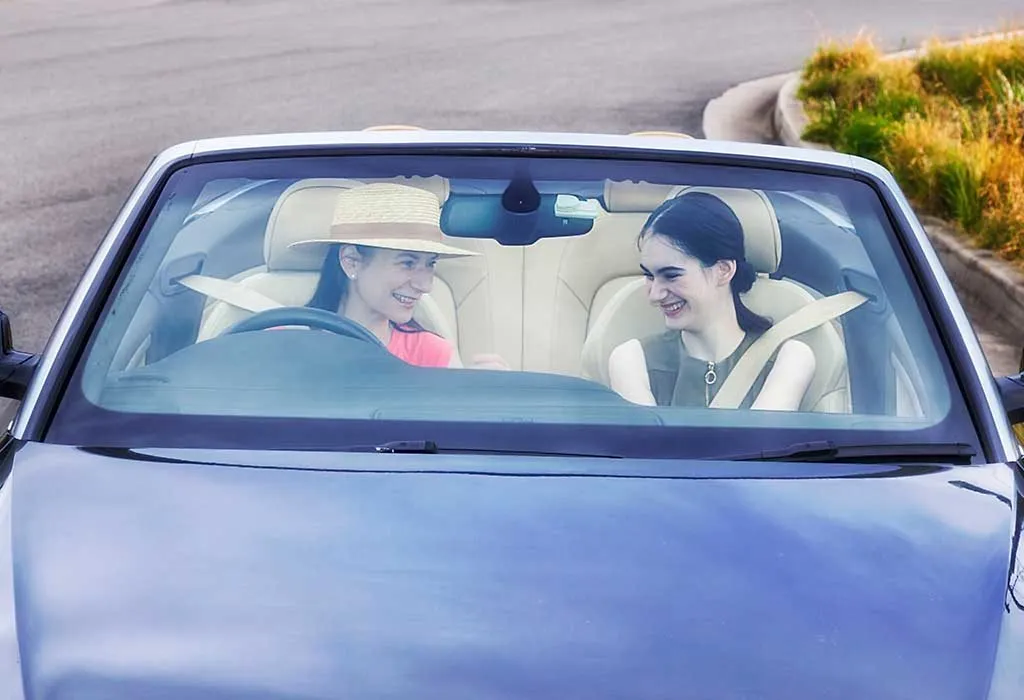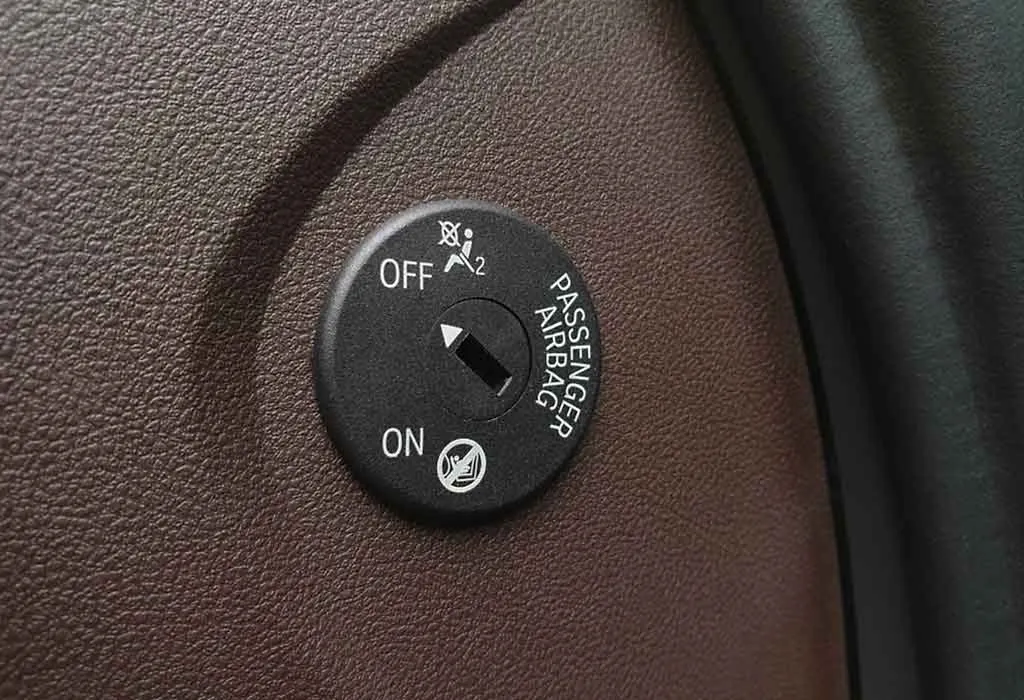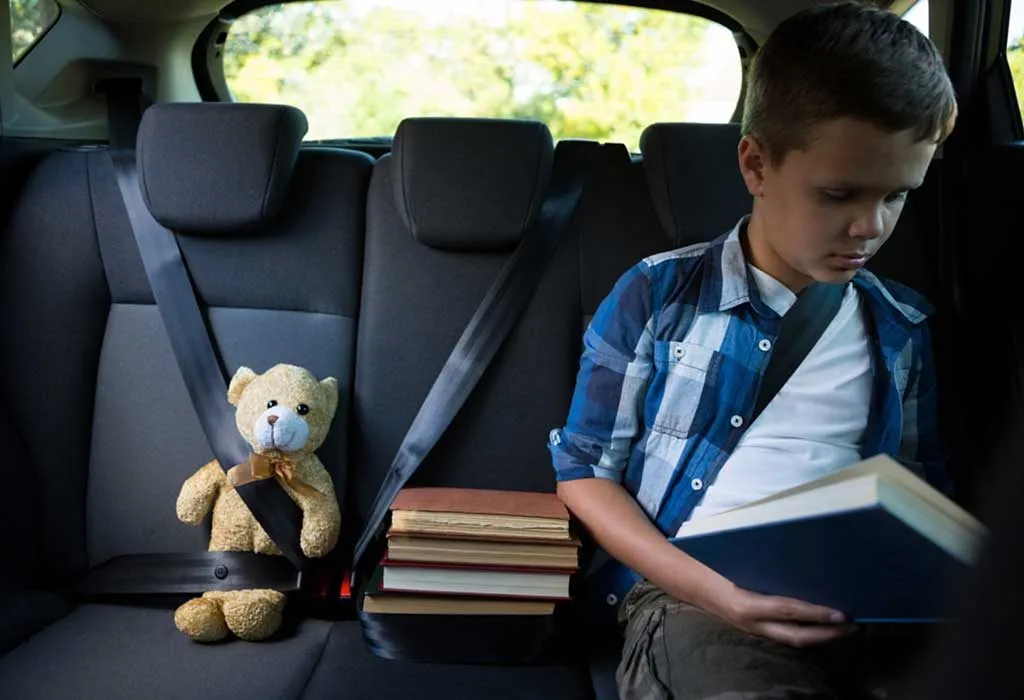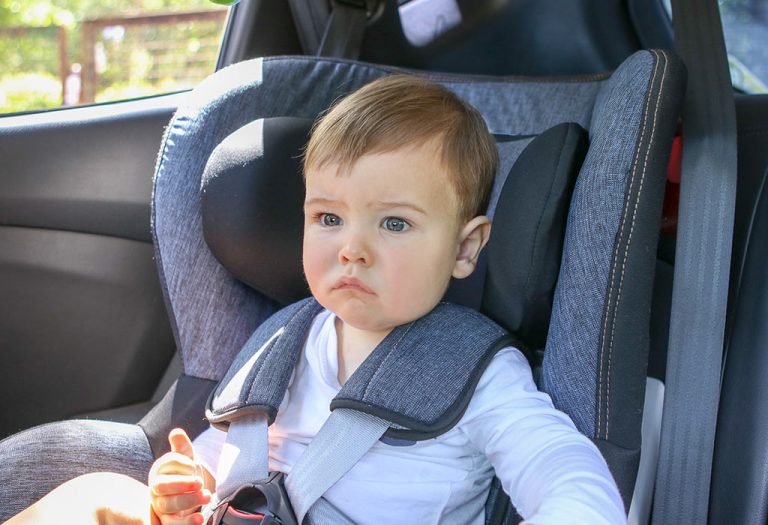At What Age Can Kids Sit in the Front Seat?

A child’s safety is of prime importance to parents. As parents, you would do your best to safeguard or protect your kid. Day-to-day activities, such as driving with your child in a car, can raise several questions, including when can kids sit in the front seat and whether it is safe for them to do so. This article will put all those questions to rest. Read on to know what age is apt for your little one to sit in the front seat and some safety rules and tips you can use to ensure he is protected.
The back seat is generally considered safer for side or rear-end impacts. Always use appropriate car or booster seats for their age, height, and weight to further ensure your child’s safety. Remember to secure them properly with the seatbelt.
When Can Your Child Sit in the Front Seat of a Car?
A child is able to use a seat belt with a booster in the age group of 8-12 years. Wondering what’s the age to sit in the front seat of a car? It’s only after 13 years of age (or when he is at least 4 feet 9 inches tall) that NHTSA (USA) recommends using front seating in the car. Sitting in the back seat is much safer for your kid than the front seat, as it puts them at lesser risk in case of an accident or collision. However, if the child is a teenager and still wishes to sit in front, a few rules should be followed for safety.
How Much Weight Should a Child Have to Sit in the Front Seat of a Car?
There is no universally mandated weight restriction for sitting in the front seat, although certain states have established regulations on this matter. Age is generally considered more crucial than weight for ensuring safe front-seat travel. Irrespective of a child’s weight, their skeletal development involves bones that are still growing and softer compared to adults. This developmental stage can affect how well seat belts fit and stay positioned correctly during a car accident.
Risk of Moving Your Child Too Early to the Front Seat
Moving your child to the front seat prematurely can pose significant risks. Children are safer in the back seat due to several factors:
- Airbag Risks: Airbags are designed for adult-sized occupants and can deploy with considerable force, posing a serious risk of injury to younger children.
- Physical Vulnerability: Children’s bodies are not fully developed, especially their skeletal structure and muscle strength, which makes them more vulnerable to injury in the event of a crash.
- Seatbelt Fit: Seatbelts are designed with adults in mind. Children may not be tall enough for the seatbelt to properly fit across their chest and lap, which can lead to improper restraint and increased risk of injury.
- Impact Forces: The front seat exposes children to greater forces during collisions, especially frontal impacts, which are the most common type of crash.
Safety Rules to Keep in Mind When a Child Is Sitting in the Front Seat
If you are planning on making your kid sit in the front seat, then it is recommended that you keep the following safety rules in mind:
1. Disable the Airbag (for kids under 13 years of age)
It is advised to disable the airbags if your child is sitting in the front seat of the car as airbags can cause severe injuries. Side airbags also can be harmful if the kids have a tendency to lean on the doors. In case your car lacks the feature of disabling airbags, you may get it installed by your car dealer. You may need to get approval from the government before making these amends to the airbags in your car. However, installing a button and deactivating it may not rule out all the possibilities of deploying.
2. Make Your Kid Sit Upright
It is important that your kid sits in an upright position in the front seat. Do not let him slouch or lie down or do any sorts of other things that may hamper the hold of the seat belt or the car seat. Leaning on the door, as mentioned in the point above, can also increase the chances of injuries upon an impact. Therefore, your child must be seated upright through the commute when riding in the front seat.
3. Secure Your Child in a Safety Harness
In case you are not able to get the airbags disabled, then it is recommended not to use boosters or car seats. Try to make your child sit with the complete safety harness. If the child is above 12-13 years (or of the required height as mentioned above), ensure his seat is pulled back with his back against the seat so he is away from the dashboard and the seat belt is harnessed properly.
4. Buckle up Your Child
Buckle up the shoulder belt and the lap belt nicely. Do not place the shoulder belt below the shoulder or behind your child. The seat belt should go across the upper chest, not the neck. The lap belt should lay across the lap, not on the stomach.
Ensure your child does not play with the seat belt as it may get entangled if he pulls the seat belt all the way out and wraps it around himself. Most seat belts have a locking mechanism that gets activated when the belt is pulled out. There are chances of injuries if the seat belt is wrapped around his head, neck, or even his waist when he is not able to free himself.
In case your child is too small to fit into a seat belt, then it is recommended to make your kid sit in a booster seat.
5. Keep the Area Around Your Kid Clutter-Free
You should make sure that there are no objects between your kid and the door of the car. Any kind of toy, pillow or other things may cause harm to your child in case the airbags inflate.
FAQs
1. Can a child sit in the front seat of a car if they are using a booster seat?
Yes, in many regions, if a child is using a booster seat, they can legally sit in the front seat. However, it’s crucial to ensure the booster seat is correctly installed and that the child meets the minimum height and weight requirements specified by local laws.
2. Are there exceptions where children can sit in the front seat at a younger age?
Some states or countries may have exceptions where children can sit in the front seat at a younger age, typically due to lack of space in the back seat or medical reasons. These exceptions usually require strict adherence to safety measures, such as disabling the passenger-side airbag or using a specific type of child restraint system.
3. Is it safe for a child to sit in the front seat of a car with side airbags?
Side airbags, like frontal airbags, can pose risks to children due to their size and height. It’s generally recommended that children under a certain age and size, often 13 years old or younger, continue to ride in the back seat where they are safer in the event of a side impact.
4. What should parents do if their child insists on sitting in the front seat?
Parents should educate their children about the risks of sitting in the front seat prematurely. It’s essential to prioritize safety over preferences and explain that the back seat is designed to provide the best protection in a crash. Setting firm rules and leading by example can help reinforce the importance of back-seat safety.
5. Can older siblings sit in the front seat while younger children remain in the back?
Yes, older siblings who meet age and size requirements can typically sit in the front seat, provided they can safely use the seatbelt and the airbags are not deactivated. However, ensure that younger children still ride in the back seat where they are safer, even if older siblings are in the front.
These are some of the tips that you should follow for the safety of your kid. It is very important that as parents, you are up-to-date with the rules of travelling with kids and you should also abide by them. As suggested previously, the front seat of a car is not the safest place for your kid. Therefore, it is important that you understand the pros and cons before allowing your kid to sit in the front seat of the car.
References/Resources:
1. Santschi. M, Lemoine. C, Cyr. C; The spectrum of seat belt syndrome among Canadian children: Results of a two-year population surveillance study (Paediatrics Child Health); National Library of Medicine; https://www.ncbi.nlm.nih.gov/pmc/articles/PMC2529446/; April 2008
2. Child Passenger Safety; CDC; https://www.cdc.gov/child-passenger-safety/about/index.html
3. Child Safety; National Highway Traffic Safety Administration; https://www.nhtsa.gov/road-safety/child-safety
4. Car Seats: Information for Families; American Academy of Pediatrics; https://www.healthychildren.org/English/safety-prevention/on-the-go/Pages/Car-Safety-Seats-Information-for-Families.aspx
5. Air Bag; Children’s Hospital of Philadelphia; https://www.chop.edu/pages/air-bags
6. Motor Vehicle Safety–Identifying High-Risk Situations; Stanford Medicine; https://www.stanfordchildrens.org/en/topic/default?id=motor-vehicle-safety-identifying-high-risk-situations-90-P02986
7. Durbin. D, Hoffman. B, Agran. P, Denny. S, et. al.; Child Passenger Safety; American Academy of Pediatrics Publications; https://publications.aap.org/pediatrics/article/142/5/e20182460/38530/Child-Passenger-Safety; November 2018
Also Read:
School Bus Safety Rules for Kids
Road Safety Rules for Children
Top Safety Rules for Kids at Home
When Can a Child Move to a Booster Seat?
Important Fire Safety Rules for Kids That You Must Teach Them
Was This Article Helpful?
Parenting is a huge responsibility, for you as a caregiver, but also for us as a parenting content platform. We understand that and take our responsibility of creating credible content seriously. FirstCry Parenting articles are written and published only after extensive research using factually sound references to deliver quality content that is accurate, validated by experts, and completely reliable. To understand how we go about creating content that is credible, read our editorial policy here.




























